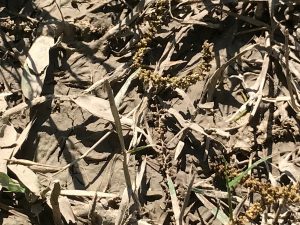A Happy, Healthy Native Tree Makes for a Potentially Prosperous Crop

Before dams were built along Texas rivers, river floods occurred often and would deposit rich nutrients and silt around the base of the trees and the orchard floor. (Photo by Larry Stein)
However, in the grand scheme of things the pounds produced by these native trees are not that great. There are obviously a number of reasons for this, but the main two are crowding—too many trees per acre—and the other is lack of growth.
Tree crowding is an ongoing issue and must be addressed almost every year. The most productive native groves are those where the trees are spaced far apart. Some people use a certain number of broad feet per acre, but in reality, the easiest system is to have half shade and half sun in the native grove when the sun is directly overhead in mid-summer—meaning that the full canopy of each tree is bathed in pure sunlight for most of the day. No calculations needed; you either have quite a bit of light or you don’t.
Another indicator of lack of light is lack of vegetation, more specifically Bermuda grass, which has to have light to grow. So if you have good Bermuda grass throughout the grove, you obviously have good light; if not, you need to look at thinning trees. Since grazing is an integral part of many native pecan bottoms, the extra light which helps the trees will also benefit the grass.
There are many cow/calf operations in Texas, and many of these are located on Texas’ numerous rivers as they typically have a lot of forage, a lot of pecan trees, and a reliable water source. Many of these operators have thinned their pecan trees to allow for grass growth and still others apply an annual application of nitrogen fertilizer to stimulate the forage growth. Those who apply an annual application of nitrogen fertilizer are more likely to make a pecan crop than those who don’t.
Over the years, the poor price for native pecans has kept producers from making serious inputs into the native pecans. We are really hopeful that the marketing order will increase the value of pecans overall, and therefore, improve the potential for these native pecan trees.
Realize that there are still other native pecan operations that make minimal fertilizer applications and their trees perform reliably year in and year out. A plausible reason for this is indirect sources of fertility, including grazing, grass breakdown, cover crops, floods, and lightning.
There is no question that grazing returns fertility back to the soil in the form of urine and feces. The amount returned is variable and is obviously not uniformly applied. There are folks who over the years have used drags to spread this material more uniformly over the native floor.
In addition, the breakdown of grass and other organic materials occurs naturally without going through an animal ruminant. This is the natural process of plant growth and senescence. Lawn grasses are very high in nitrogen content and at least 40 percent of the nutrients in these grass clippings are returned to the soil if they are composted or mulched in place, i.e. let the clippings decompose in place. This does take time, but it typically happens in a short period. So, mowing of an orchard or grove floor does a similar job as grazing and, again, deposits these materials on the floor, allowing for decomposition.
Some have carried this process one step further and don’t simply use the native grass, but rather plant cover crops such as legumes. Legumes are plants which will naturally fix nitrogen. They have nodules on the roots which allow this process to happen. Common legumes in nature include clovers, bluebonnets, and mesquite trees to name a few. Still, as a general rule of thumb, these plants only fix nitrogen if they are really stressed and need the nutrition, and it is the plant foliage which contains the nitrogen which again has to be broken down and released back into the soil as with the mowed grass above.
Another indirect source of fertility is lightning. Have you ever wondered why things seem to look so much better after thunderstorms? No doubt the water is part of the reason, but this water is also infused with a bit of nitrogen from the lightning in thunderstorms. It has been estimated that a good thunderstorm returns 8 to 10 pounds of nitrogen per acre. So not only are you getting really clean water but also some really beneficial nitrogen fertilizer.
The other thing to consider is that pecan bottoms are not just called that, but rather the name is a dead giveaway as to what and where they are. These are bottomland areas and this is naturally where the excess water from a rainstorm will travel. If you get a two-inch rain above the bottom and if there is runoff, you may get 4 to 6 inches of rain in the bottom. Here, you get more water as well as more potential fertility.
In addition, this runoff water also contains silt, which is high in nutrients. In fact, before the numerous dams on the various rivers, it was a common occurrence for river floods to come across native bottoms and deposit a rich layer of nutrients along with the water.
Indeed, there are other sources of fertility other than directly applying fertilizer. Even though the process to get this nutrition may seem different, it is really all the same because the trees use the exact same nutrients regardless of how it is applied.
So make a note of your tree growth this spring and correlate it with production. If lacking, you may want to consider adjusting your fertility program because no doubt tree health plays a large role in the production of a pecan crop. The healthier you can keep your trees, the more potential you have for a crop.


